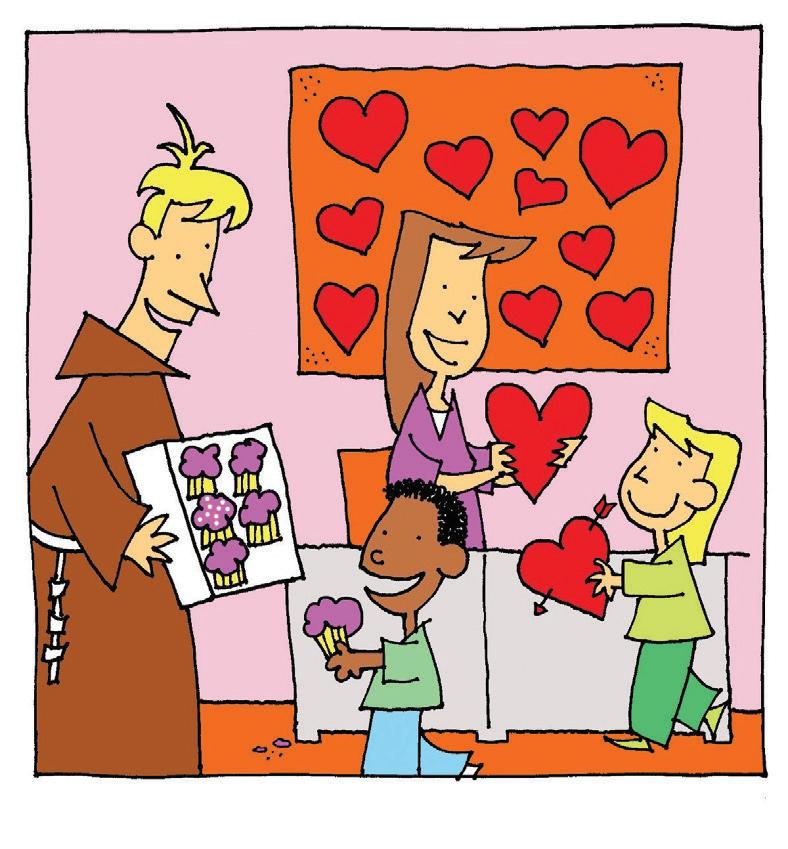
14 minute read
Faith & Family | Susan Hines-Brigger

Susan Hines-Brigger
Advertisement

Susan has worked at St. Anthony Messenger for 27 years and is an executive editor. She and her husband, Mark, are the proud parents of four kids— Maddie, Alex, Riley, and Kacey. Aside from her family, her loves are Disney, traveling, and sports.
Susan welcomes your comments and suggestions!
EMAIL:
CatholicFamily@ FranciscanMedia.org
MAIL:
Faith and Family 28 W. Liberty St. Cincinnati, OH 45202
WANT MORE? VISIT: FranciscanMedia.org/ faith-and-family
The Reality of Love
Ihave a confession to make: Sometimes I don’t like my kids. Th e same thing goes for my husband, Mark, too. And I’m pretty sure they would tell you the same thing about me. And that’s OK. Because we never promised to like each other all the time. We promised to love each other, and there’s a big diff erence.
Th at’s because liking something is fl eeting. It can ebb and fl ow, such as what my kids are willing to eat for dinner. We tend to like things such as food, music, movies, TV shows, and sports teams. It is the reason that kids usually talk about liking each other rather than loving each other. Like gives us an exit plan. When we like something, on any given day, we may decide that certain thing no longer serves a purpose for us, and we move on.
But I don’t think love is like that. Love is a permanent commitment. Love sticks around, even when we would rather turn and run the other way as fast as we can. Like would run. Love stays put and stands on the shaky ground. Th at is because love requires putting in the work—even when you don’t feel like it.
LOVE NEVER FAILS
Whenever I think about the idea of love, I always think back to when Mark and I were planning our wedding ceremony almost 27 years ago. When it came time to pick out the readings for the Mass, there was one, in particular, that I wanted. We both wanted it, actually, but I’m not sure about his reasoning. I knew mine, though.
Th e reading was the very popular reading for weddings from 1 Corinthians 13. I’m sure you’ve all heard it. In fact, most people can quickly quote the fi nal line, “So faith, hope, love remain, these three; but the greatest of these is love” (13:13). And, while I think the whole reading is beautiful, that’s not the message that drew me in.
Th e words in the reading that stuck with me were ones I thought spoke so eloquently to the love Mark and I were getting ready to promise to one another. Th ose words were: Love “bears all things, believes all things, hopes all things, endures all things. Love never fails” (13:7–8). Th ey seemed to dig down a little bit deeper into the reality of love for me. Maybe it was the word endures that caught my attention. It seemed to imply that this journey we were starting wasn’t going to always be as magical as our wedding day.
LOVE ENDURES
In hindsight, I can see that my instincts were right. Endure is a very good word for summing up a marriage—and parenthood, for that matter. But it doesn’t work without the other part. For instance, when I was diagnosed with MS, I knew that Mark and I would have to endure some rough times. Even in those times, though, Mark’s love and support have soft ened the trials a bit.
When my kids haven’t liked me or Mark because of something that we’ve made them do or not do, we take comfort in knowing that love was 100 percent behind our decision. Love is the key word. For, even on days when we don’t really like each other, and it seems as if we’re just putting up with each other, we can take comfort in knowing that love is right there to help.
So, no, my family doesn’t always like each other. In that, I suspect we’re not much diff erent than most people. What I do know, though, is that we love each other. And that endures.
Love has asked a lot of me lately.
For two years and 10 months, I had been an advocate appointed by the family court for a boy whose parents were on drugs and whose dad had abused him in several ways. Though a warrant was out, Dad could not be located. Good! I followed this boy through four foster-care settings, two schools (he’d been in at least five before we met), and now residential treatment in an institution.
Somehow, he was overmedicated and ended up in a hospital for four days. His social worker felt that he should leave a facility that would make such a dangerous error. Through various networks available to the social services system and another agency founded by Dave Thomas of Wendy’s fame, the entire state of Kentucky was canvassed twice, searching for another home for this boy, now an 11-year-old.
But he was indeed an 11-year-old, had many behavioral issues, found transitions difficult, and had been removed from several homes already. No one in the entire state responded to this cry for help, this cry for love, this cry for security.
A social work supervisor, whom I don’t remember ever meeting, suggested at an emergency meeting that I might want to take this boy. I knew him; I knew his history; he seemed to care for me. I am practically eligible for greatgrandparenting, not fostering a troubled child. I have a peaceful life. I can write, I can garden, I can have a rather casual no-alarm-clock-needed schedule.
I also have a wonderful husband, so I couldn’t possibly make such a life-altering decision without his full support and engagement. I was sure he would remind me of all the reasons this would be an unworkable, impossible, and absolutely insane decision. When I choked out this startling invitation, Larry just said, quite simply, “Yes!”
I cried, I called, he came. He came with history and with troubles. He is as tall as my husband and me and has a cute nose and beautiful blue eyes. He is underweight (unlike us). He came with two pieces of well-used luggage and lots of boxes containing Legos, clothes, stuffed animals, dolls, and toys—but lacking something he needed.
Do we have it? We hope so. We reworked our staid guest room into a Batman cave. Its generous walk-in closet is intended as a cooling-off space. My husband put in a punching bag. Generous friends gave us a beanbag chair and lots of moral support.
It hasn’t been long. I have been notified by our newest resident that I’m an “old lady.” I have been told I am strict by an 11-year-old and “soft” by my husband. I’ve been “mean.” I’ve been “rude.” I’ve gotten hugs but am not allowed to touch him first. He growls, frowns. He sings in the shower— when he’s willing to take one. He has said the water hurts him and makes his skin wrinkle. We’ve compromised on every-other-day hygienic showers, pending a sniff test. But my nose can’t get too close.
But my heart has gotten really, really close. When we say, “I love you,” he says it back. His favorite song is “Mom,” by Meghan Trainor. It’s not about me. For him, it’s about a woman who has no rights over him anymore. She is on parole, I think, but she left him with strangers and allowed terrible things to happen for nearly nine years until pesky things like law enforcement, a judge, several social workers, and I became involved. She didn’t make her court appearances. She’s in the wind.
We are in love.
Carol Ann Morrow
—Carol Ann Morrow
Friar Pete & Repeat


These scenes may seem alike to you, but there are changes in the two. So look and see if you can name eight ways in which they’re not the same. (Answers below)
7) One cupcake has sprinkles. 8) The girl’s shirt has long sleeves. 4) A fold in the cupcake box is no longer there. 5) There is an arrow in the girl’s Valentine heart. 6) The desk has legs. ANSWERS: 1) There is another heart on the board. 2) The back of the chair is now flat. 3) The boy’s cupcake has more icing.
StAnthonyMessenger.org | February 2022 • 45
Stephen Copeland
Stephen Copeland is a storyteller and an Indiana native who now lives in Charlotte, North Carolina. He recently published his first memoir, Where the Colors Blend, about his journey from doubt and despair to a place of faith and hope. He’s been published widely in this magazine and at FranciscanMedia.org. You can follow his work at CopelandWrites.com.
WANT MORE? Check out our daily online prayer resource, Pause+Pray: FranciscanMedia.org/ pausepray
Live in Me, Love in Me, Act in Me

Etched on the back of my mother’s headstone are three simple prayers: “Lord, live in me, love in me, and act in me.”
Adapted from Clarence Enzler’s Everyone’s Way of the Cross, these prayers not only perfectly describe my mother’s life, which ended suddenly in February 2021, but also echo a ritual she loved during Lent: the Stations of the Cross.
My family religiously attended “Stations,” as we called it, every Friday during Lent throughout my youth. Honestly, I didn’t get it. The Stations of the Cross—14 scenes marking Jesus’ journey to the crucifixion—felt like a terribly depressing story that always ended the same. What was the point? But I liked that it was only a half hour, and it came with tomato soup and garlic bread in the school cafeteria afterward. My parents, on the other hand, loved the Stations so much that they snagged Enzler’s book from the parish foyer so they could practice outside of Lent. It’s not really stealing, I guess, if it helps you pray.
As I got older, I stopped going to the Stations. I got my degree. I started my career. I moved south. I attended several nondenominational churches. Authors like Thomas Merton and Henri Nouwen resurrected for me rich contemplative practices in Catholicism I had long misunderstood. Still, the Stations remained something yet to be rediscovered on my spiritual walk.
When Mom’s life was ripped from us last year, one of the few things I remember from that week—of awakening day after day in the middle of a nightmare—was gathering in the warmth of my family’s living room on a snowy, Indiana day. We were weary from shock and tears, but Dad, with great strength and humility, took out his and Mom’s worn book and dared to read through Everyone’s Way of the Cross.
It all came rushing back. Why was this form of prayer so beautiful? What was it about the Stations that meant so much to my mother? We never got the chance to ask her.
PRAYERFUL GAZE
Early Franciscans were moved by Jesus’ journey to Calvary as well. St. Francis, St. Clare, and Angela of Foligno all practiced gazing upon the crucifix as a form of contemplative prayer. It’s likely their imaginations were stirred to intimately experience different moments on the road to Jesus’ crucifixion. Their prayerful stance led to an embodied faith, as they were moved to let the Lord live in them, love in them, and act in them, as
St. Francis became the first person to receive the stigmata.
All of this might be why the word Incarnation is a uniquely Franciscan term. Loving service and humble obedience become increasingly more natural to us when we place our “mind before the mirror of eternity,” as St. Clare encourages.
Perhaps because of St. Francis’ emphasis on the Incarnation, Franciscans began erecting the Stations in different places for prayer. By the 18th century, permission was granted to erect the Stations in churches as long as they were built by Franciscans and approved by a bishop. Today I wonder: What am I building in my own inner sanctuary? Am I erecting sacred statues that inspire a prayerful gaze as I carry my own cross or selfish idols that distract?
14 STEPS
As I reflect upon my mother’s life, I’m moved by how she carried her own crosses. I wonder how the Stations may have influenced that journey, perhaps without her even knowing it. Ritual has a way of getting deep in your bones, the truest form of prayer. Mom struggled for decades to “feel anything” at Mass, yet that spiritual desert never stopped her from going, nor from praying the Stations.
Her life was marked by humble obedience and small acts of kindness each day. She took Enzler’s prayer to heart: “Lord, make me realize that every time I wipe a dish, pick up an object off the floor, assist a child in some small task, or give another preference in traffic or the store; each time I feed the hungry, clothe the naked, teach the ignorant, or lend my hand in any way. . . . The kindness I extend to them I really give to you.” A couple weeks before Mom passed away, she caught herself “overhelping,” as she sometimes did, and laughed, “Oh, misguided helpfulness,” a phrase from Enzler’s book.
Mom was never one for deep spiritual or philosophical conversations, but she, like the early Franciscans, modeled an embodied faith, where simple obedience to love’s daily call made her a cultivator of joy. I’m learning in my own darkness and depression that unpleasant feelings do not have to evoke avoidance but can, instead, deepen my values.
During that awful week a year ago, Dad texted my sisters and me a question about Mom’s burial. It was some kind of absurd logistical question you don’t fathom asking until much later in life, when your parents have had the opportunity to become grandparents. Dad misspelled cemetery, which autocorrected to veneration.
It’s silly, but I think about that a lot. As Enzler’s introduction in Christ’s voice invites: “My life was incomplete until I crowned it by my death. Your 14 steps will only be complete when you have crowned them by your life.”


LIVE, LOVE, ACT
Lord, live in me— as I dare to pick up my cross and place one foot after another.
Lord, love in me— when my strength fades and night stretches into morning.
Lord, act in me— embolden my will and embody my being.
Amen.
ACTION STEPS
• COMMIT to going through the
Stations of the Cross each week.
Whether attending in person or virtually, slow your breathing and enter into stillness. Each time an unrelated thought rises up, redirect your mind toward the words or images.
• READ a passage from Scripture at each Station and spend time sketching or writing a prayer in response.
• GO through one Station each morning. Consider a word or phrase that resonates with you, and come back to it throughout the day.
The color of springtime is flowers. The color of winter is in our imagination.
—Terri Guillemets

LIVE IN THE SPIRIT OF ST. FRANCIS WITH
St. Anthony Messenger was fi rst published in 1893. In the fi rst issue, founding editor Father Ambrose Sanning wrote that the 40-page magazine “is a herald of peace.” Today, St. Anthony Messenger continues to help its readers become heralds of peace through delivering the Gospel message and Catholic perspective.
With articles written by Franciscan friars, Secular Franciscans, and those who share the Franciscan vision, St. Anthony Messenger focuses on today’s events, using the lives of St. Francis, St. Clare, and others as models to inform, inspire, and connect readers everywhere. “ “ “This is the best Catholic magazine I’ve ever received. It’s understandable, approachable, and doesn’t shy away from controversial topics. It’s just so inspirational. I love it!” —St. Anthony Messenger subscriber
Within each issue, experience: • Followers of St. Francis: inspiring, encouraging stories of
Franciscans making a difference in the world • Ask a Franciscan: Franciscan answers to your questions • Faith-related topics and other social issues discussed through a
Franciscan lens • Stories that share the extraordinary lives of the saints • Other resources to help you grow in your faith daily Subscribe today! Come see the reason why St. Anthony Messenger has been helping readers live more fully human and Christian lives for over 125 years!
Subscribe today! www.FranciscanMedia.org/SAM22
or fi ll out the form on page 8 of this issue

















